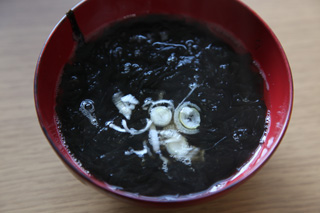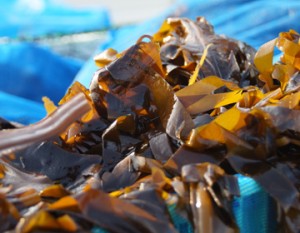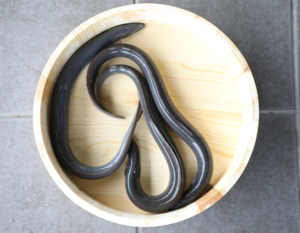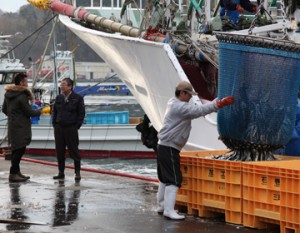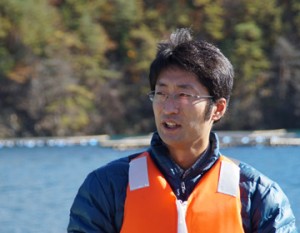Out to sea, early in the morning.
It was before six o’clock. The sun hadn’t yet risen, but Nakata was on a boat. He was out at sea early in the morning to experience ”nori” harvesting with Futoshi Aizawa a ”nori” farmer.
Just like tea harvesting, there is first flush, second flush and third flush of ”nori” harvesting. We were taken to the first flush harvesting. We knew it would be cold, so we were prepared, but it was so very cold. ”It not that cold today.” laughed Aizawa (the interview took place in late November). At the height of the harvesting season in January to February, the temperature goes down to minus 8 degrees Celsius. It made us shiver just thinking of such cold temperatures.
Harvesting began in these cold conditions. When the rafts were pulled out of the water, the nets were totally covered with black ”nori”. The nets are fed into harvesting machines. One raft consists of six nets that are 2 meters wide and 20 meters long. Aizawa and his team managed 300 rafts.
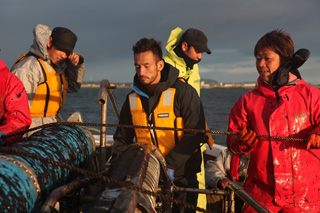
“Nori” fit to be presented to the Emperor
Aizawa’s ”nori” farm is in Omagarihama, Higashi Matsushima-shi. Omagarihama’s ”nori” is valued as the ”nori” of highest quality. It was honored as the ”Nori presented to the Imperial Family” at contests held in Shiwahiko Shrine and Shiogama Shrine for 6 consecutive years until 2011.
Restoring seaweed farming after the earthquake disaster
However, everything was lost with the Great East Japan Earthquake. Everything that was build up over many years was lost – the lives of fellow workers, houses, facilities and much more. Many fishermen quit ”nori” farming. But Aizawa did not give up. He began to search for a way to rebuild soon after the disaster, and after one year, he began to made headway. It was just a few days before our visit that he was able to harvest for the first time since the disaster.
He used to work as a ”team”, but now Aizawa and two colleagues are working as a cooperative group.
”But in the future, we hope to be working as rivals again.” said Aizawa.
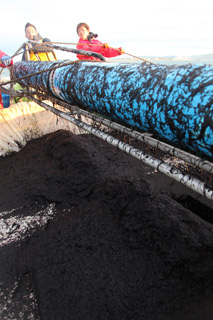
All you need is rice and “nori”.
During our visit, the harvesting continued non-stop. Nakata helped. When the harvesting was finally over, Nakata asked ”what sort of ”nori” are you aiming for?”. Aizawa answered, ”something that is so delicious that all you need is ”nori” and rice as a meal.”
”The most delicious ”nori” is the one straight out of the sea and dried. When lightly toasted, it smells absolutely delicious and goes very well with steamed rice.”, he said, and he took a sheet of ”nori” he had just processed the day before, and roasted it over the stove. A savory aroma filled the air, and when placed into the mouth, it melted smoothly away. It had a very fresh taste. And the broth made of raw ”nori”, which can only be enjoyed at the beach, tasted fresh too. It was a luxury, with just a drop of soy sauce.
Bringing Omagari seaweed to more people
Aizawa shared his resolution.
”We have resumed ”nori” farming, but that’s not enough. We want to reestablish awareness for Omagari ”nori”. So we need to keep on making delicious ”nori”.”

